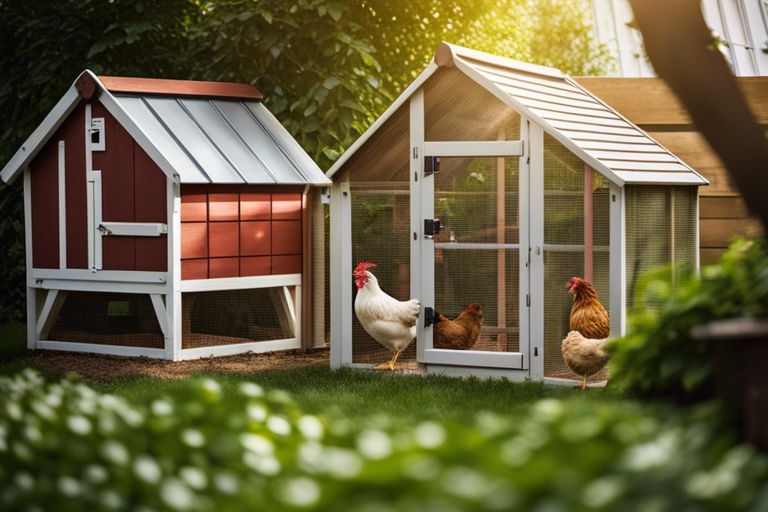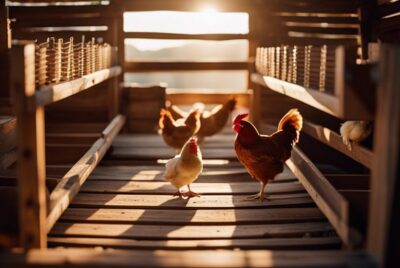Choosing the Right Chicken Coop – A Comprehensive Guide"
When it comes to setting up your own flock of chickens, investing in the right coop is crucial for the health, safety, and happiness of your feathered friends. With so many options on the market, it can be overwhelming to decide on the perfect fit for your specific needs. In this comprehensive guide, we will walk you through all the factors to consider when choosing the right chicken coop, from size and design to materials and additional features. By the end of this article, you will feel confident in making an informed decision that will benefit both you and your chickens.
Understanding Different Types of Chicken Coops
Before stepping into the specifics of each type of chicken coop, it’s essential to understand the different options available. By knowing the characteristics of traditional wooden coops, plastic coops, and mobile chicken tractors, you can make an informed decision on which option best suits your needs.
| Traditional Wooden Coops | Plastic Coops |
| Sturdy and durable | Lightweight and easy to move |
| Natural insulation | Low maintenance |
| Classic look and feel | Resistant to rot and decay |
| Require regular maintenance | Limited customization options |
| Can be more expensive | May not be as predator-proof |
Traditional Wooden Coops
An excellent choice for those looking for a classic and sturdy coop option, traditional wooden coops offer natural insulation and a timeless appearance. These coops require regular maintenance to ensure their longevity and functionality. While they may be more expensive upfront, their durability and traditional charm make them a popular choice among chicken owners.
Plastic Coops
On the other hand, plastic coops are lightweight, easy to move, and require minimal maintenance. They are resistant to rot and decay, making them a long-lasting option for chicken keepers. While they may lack the traditional appeal of wooden coops, plastic coops offer practicality and convenience for those looking for a low-maintenance coop solution.
Different from traditional wooden coops, plastic coops are a modern alternative that provides a lightweight and durable housing option for your chickens. These coops are often more cost-effective and easier to clean than wooden coops, making them a popular choice for novice chicken keepers or those looking for a hassle-free coop option.
Mobile Chicken Tractors
Plastic mobile chicken tractors offer the flexibility of easily moving your chickens to fresh pasture regularly. By providing a secure and enclosed space for your birds to forage, these tractors mimic the natural behavior of chickens in the wild. This mobility promotes the health and well-being of your chickens while also benefiting your land by evenly distributing their waste.
Traditional wooden chicken coops have their advantages and disadvantages when compared to plastic coops. While wooden coops offer a classic and sturdy design, they require regular maintenance and may come at a higher cost. On the other hand, plastic coops are lightweight, low maintenance, and more cost-effective, but they may not provide the same level of insulation as wooden coops.
Comparing Pros and Cons
| Pros | Cons |
| Sturdy and durable | Require regular maintenance |
| Natural insulation | May be more expensive |
| Classic look and feel | May not be as predator-proof |
| Low maintenance | Limited customization options |
| Resistant to rot and decay |
Factors to Consider When Choosing Your Coop
Keep in mind that selecting the right chicken coop is essential for the well-being of your flock. There are several factors to consider when making this decision, ensuring that your chickens are safe, comfortable, and productive.
Size and Capacity Needs
One of the crucial aspects to consider is the size of the coop in relation to the number of chickens you plan to keep. Allow ample space for the chickens to move around freely, perch, nest, and access food and water. A general rule of thumb is to provide at least 2-3 square feet of space per chicken inside the coop, along with outdoor space for them to roam.
When determining the capacity of the coop, factor in potential growth in your flock. It’s better to invest in a slightly larger coop from the beginning rather than having to upgrade later on. Adequate space is vital for the overall health and happiness of your chickens.
Location and Climate Considerations
To ensure the comfort of your chickens, select a location that is well-drained and free from dampness. The coop should be situated in an area that receives ample sunlight and is sheltered from harsh winds. Consider the climate of your region and choose a coop design that provides insulation in colder climates or good ventilation in hotter regions.
Choosing a spot with good drainage will prevent puddles from forming inside the coop and reduce the chances of moisture-related health issues for your chickens.
Security Against Predators
The safety of your chickens is paramount, so the coop must be predator-proof. Ensure that the coop is constructed with sturdy materials and features secure latches on doors and windows. Additionally, consider adding an apron or wire mesh buried around the perimeter of the coop to deter burrowing predators.
The coop should also have a secure roof to prevent aerial predators like hawks or owls from attacking your chickens. Regularly inspect the coop for any vulnerabilities and make necessary repairs promptly to keep your flock safe.
Consider installing motion-activated lights or alarms to further deter nighttime predators and provide added security for your chickens.
Step-by-Step Guide to Selecting Your Chicken Coop
To ensure the comfort and safety of your feathered friends, choosing the right chicken coop is crucial. Follow this comprehensive guide to make an informed decision that meets your flock’s needs and budget.
| Assessing Your Flock’s Needs | Budgeting and Cost-Effective Options |
|
With a clear understanding of your flock’s size, breed, and behavior, you can determine the ideal coop size, nesting boxes, and roosting bars they require. |
To ensure a chicken coop that fits your budget, consider pre-built structures, DIY options, or repurposed materials for cost-effective solutions. |
Assessing Your Flock’s Needs
With a clear understanding of your flock’s size, breed, and behavior, you can determine the ideal coop size, nesting boxes, and roosting bars they require. Consider factors such as the climate in your area, predator threats, and the number of chickens you plan to keep when selecting a coop design.
Budgeting and Cost-Effective Options
To ensure a chicken coop that fits your budget, consider pre-built structures, DIY options, or repurposed materials for cost-effective solutions. Assess your financial resources and prioritize features that are essential for your chickens’ well-being while exploring affordable alternatives in coop construction.
Coop: Before making a purchase, factor in ongoing maintenance costs, such as cleaning supplies, bedding, and feed. Opt for durable materials that require minimal upkeep to save in the long run.
Preparing the Site for Your Chicken Coop
Choosing a suitable location for your chicken coop is crucial for the health and safety of your poultry. Ensure the site is well-drained, secure from predators, and receives adequate sunlight. Clear the area of debris and level the ground for stable construction.
Chicken: Remember to provide adequate space around the coop for your chickens to roam freely during the day. Consider fencing options to establish boundaries and protect your flock from potential dangers.
The Purchase Process
Guide: Once you have assessed your flock’s needs, set a budget, and prepared the site, it’s time to purchase the chicken coop. Compare different suppliers, read reviews, and consider additional features like ventilation, insulation, and easy access for cleaning.
Maintenance: Regularly inspect the coop for signs of wear and tear, repair any damages promptly, and keep the interior clean to prevent health issues among your chickens. Assume that preventative maintenance is key to prolonging the lifespan of your chicken coop.
- Assume that the upkeep of your chicken coop is an ongoing responsibility that requires regular attention to ensure your chickens’ well-being.
Pros and Cons of Common Coop Choices
Not all chicken coops are created equal. When choosing the right coop for your feathered friends, it’s important to weigh the pros and cons of each option. Here is a comprehensive breakdown of the common coop choices:
| Coop Choice | Pros and Cons |
| Traditional Wooden Coops | Pros: Classic look, good insulation. Cons: Require more maintenance, can be heavier. |
| Plastic Coops | Pros: Lightweight, easy to clean. Cons: Less durable, may not provide as much insulation. |
| Mobile Coops (Chicken Tractors) | Pros: Easy to move around for fresh grazing. Cons: Limited space, may not provide enough protection from predators. |
| DIY Coops | Pros: Customizable, cost-effective. Cons: Time-consuming to build, may not be as sturdy as pre-made options. |
Balancing Cost and Quality
Pros: Finding the right balance between cost and quality is essential when choosing a chicken coop. While it can be tempting to opt for the cheapest option available, investing in a higher quality coop can save you money in the long run. High-quality coops are more durable and provide better protection for your chickens, ultimately saving you from having to replace a flimsy coop or deal with predator attacks.
When considering cost, think about the long-term benefits of a well-built coop. While the initial investment may be higher, the peace of mind knowing your chickens are safe and secure is priceless. Note, a good quality coop is a wise investment that will benefit both you and your feathered friends.
Weighing Aesthetics Against Functionality
Weighing the importance of aesthetics against functionality is crucial when choosing a chicken coop. While you want a coop that looks attractive in your backyard, it’s essential to prioritize functionality to ensure the well-being and safety of your chickens. A visually appealing coop is great, but make sure it also meets all the necessary requirements for your chickens to thrive.
Common considerations when weighing aesthetics against functionality include the size of the coop, ventilation, and ease of access for cleaning and egg collection. A balance between aesthetics and functionality will result in a coop that not only looks good but also provides a comfortable and safe environment for your flock.
Ease of Cleaning and Upkeep
Cost is an important factor to consider when evaluating the ease of cleaning and upkeep of a chicken coop. While some coops may be more affordable upfront, they could end up costing you more time and money in the long run if they are challenging to clean and maintain. Investing in a coop that is easy to clean will save you time and effort in the long term.
When assessing the ease of cleaning and upkeep of a coop, consider features like removable floors, access doors, and ventilation options that make these tasks simpler. A well-designed coop will not only provide a comfortable living space for your chickens but also make your life as a chicken owner much more manageable.
Final Words
So, when it comes to choosing the right chicken coop for your feathered friends, it’s essential to consider various factors such as size, material, ventilation, and predator protection. By following this comprehensive guide, you can make an informed decision that will provide a safe and comfortable environment for your chickens to thrive. Investing in a high-quality coop will not only benefit your birds but also give you peace of mind knowing that they are well-protected. Recall, a well-designed chicken coop is key to a successful poultry operation, so choose wisely!



